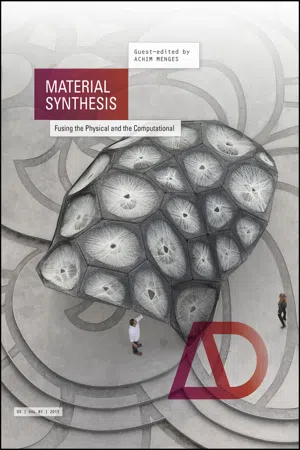
- English
- PDF
- Available on iOS & Android
About This Book
Material Synthesis: Fusing the Physical and the Computational Guest-edited by Achim Menges
A new understanding of the material in architecture is fast emerging. Designers are no longer conceiving of the digital realm as separate from the physical world. Instead computation is being regarded as the key interface for material exploration and vice versa. This represents a significant perceptual shift in which the materiality of architecture is no longer seen to be a fixed property and passive receptor of form, but is transformed into an active generator of design and an adaptive agent of architectural performance. In stark contrast to previous linear and mechanistic modes of fabrication and construction, materialisation is now beginning to coexist with design as explorative robotic processes. This represents a radical departure from both the trite modernist emphasis on 'truth to materials' and the dismissal of materials by the previous generation of digital architects.
The issue features designers, researchers and thinkers that are at the forefront of exploring new modes of material enquiry and its deep interrelationship with technology, biology and culture. Through their work, which unfolds from multifaceted alliances between the fields of design, engineering and natural sciences, it seeks to trace the emergence of a novel material culture in architecture.
- Architectural and engineering contributors include: Sean Ahlquist, Martin Bechthold, Philippe Block, Karola Dierichs, Jan Knippers, Achim Menges, Neri Oxman, Steffen Reichert and Tobias Schwinn.
- Scientific and philosophical perspectives provided by: Mario Carpo, Manuel De Landa, Neil Gershenfeld and Thomas Speck.
- Features the design research of: Harvard's Material Processes and Systems Group, MIT's Mediated Matter Group and Stuttgart University's Institute for Computational Design.
Frequently asked questions
Information
Table of contents
- Cover
- Title Page
- Contents
- Copyright Page
- Editorial
- About the Guest-Editor
- Introduction Fusing the Computational and the Physical: Towards a Novel Material Culture
- The New Materiality
- The New Science of Form-Searching
- The New Cyber-Physical Making in Architecture: Computational Construction
- Self-X Materials and Structures in Nature and Technology: Bio-inspiration as a Driving Force for Technical Innovation
- Fibrous Tectonics: Achim Menges and Jan Knippers
- ICD/ITKE Research Pavilion 2012: Coreless Filament Winding Based on the Morphological Principles of an Arthropod Exoskeleton
- ICD/ITKE Research Pavilion 2013–14: Modular Coreless Filament Winding Based on Beetle Elytra
- ICD/ITKE Research Pavilion 2014–15: Fibre Placement on a Pneumatic Body Based on a Water Spider Web
- Performative Wood: Physically Programming the Responsive Architecture of the HygroScope and HygroSkin Projects
- Structural Stone Surfaces: New Compression Shells Inspired by the Past
- Membrane Morphologies: Heterogeneous Forces and Articulated Material Form
- Granular Morphologies: Programming Material Behaviour with Designed Aggregates
- Fabrication Agency: Landesgartenschau Exhibition Hall
- Templating Design for Biology and Biology for Design
- Hacking Science: The ALivE Group’s Material Design Methods for Interdisciplinary Enivornments
- Computational Design and Automotive Material Gestalt: Cross-disciplinary Design Research by the Mercedes-Benz Center of Advanced Design and the Institute for Computational Design (ICD), University of Stuttgart
- Macrofabrication with Digital: Materials Robotic Assembly
- Counterpoint: Actualising (Overlooked) Material Capacities
- Contributors
- What is Architectural Design?
- Fothcoming Titles
- Back Cover
- EULA